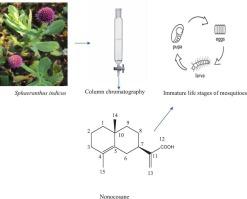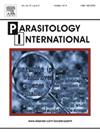Active constituent nonacosane from Sphaeranthus indicus (Asterales: Asteraceae) leaves as a potent larvicidal agent against Aedes aegypti (Diptera: Culicidae) and Culex quinquefasciatus (Diptera: Culicidae)
IF 1.9
4区 医学
Q3 PARASITOLOGY
引用次数: 0
Abstract
Mosquitoes are major carriers of diseases such as dengue, lymphatic filariasis, malaria, chikungunya, and Japanese encephalitis, as they feed on blood and act as ectoparasites. This study focuses on the effectiveness of a plant-derived insecticide, specifically the hexane extract from Sphaeranthus indicus leaves, against Aedes aegypti and Culex quinquefasciatus mosquitoes. By conducting phytochemical extraction, fractionation, and spectroscopic analysis, ten fractions were isolated. One of these fractions showed significant mosquito-killing activity, with nonacosane identified as the primary active component. Various bioassays, including tests for eggs, larvae, and pupae, were conducted. Nonacosane exhibited ovicidal activity, with effectiveness rates of 16.4 % and 17.8 % at 2 ppm against Ae. aegypti and Cx. quinquefasciatus, respectively. Larvicidal and pupicidal tests further confirmed its strong activity, with LC50 values of 2.63 ppm and 2.47 ppm for larvae, and 2.98 ppm and 2.67 ppm for pupae of Ae. aegypti and Cx. quinquefasciatus, respectively. The mosquitocidal effectiveness of nonacosane was comparable to that of established insecticides like azadirachtin and temephos. This research highlights the potential of plant-based compounds in developing effective and environmentally sustainable mosquito control strategies, especially in light of the increasing resistance to synthetic insecticides.

从印度沙蚊叶中提取有效成分壬烷醚,对埃及伊蚊(双翅目:库蚊科)和致倦库蚊(双翅目:库蚊科)有较强的杀幼虫作用。
蚊子是登革热、淋巴丝虫病、疟疾、基孔肯雅热和日本脑炎等疾病的主要携带者,因为它们以血液为食并充当体外寄生虫。本研究主要研究了一种植物源性杀虫剂,特别是从白球叶中提取的己烷提取物对埃及伊蚊和致倦库蚊的有效性。通过植物化学提取、分馏和光谱分析,分离得到10个组分。其中一种组分具有显著的杀蚊活性,其主要活性成分为壬烷醚。进行了各种生物测定,包括卵、幼虫和蛹的试验。在2 ppm浓度下,壬烷醚对伊蚊的杀卵率分别为16.4 %和17.8 %。埃及伊蚊和Cx。分别quinquefasciatus。对伊蚊幼虫和蛹的LC50分别为2.63 ppm和2.47 ppm,对蛹的LC50分别为2.98 ppm和2.67 ppm。埃及伊蚊和Cx。分别quinquefasciatus。壬烷的杀蚊效果与印楝素和双硫磷等现有杀虫剂相当。这项研究强调了植物基化合物在开发有效和环境可持续的蚊虫控制策略方面的潜力,特别是考虑到对合成杀虫剂的抗性日益增加。
本文章由计算机程序翻译,如有差异,请以英文原文为准。
求助全文
约1分钟内获得全文
求助全文
来源期刊

Parasitology International
医学-寄生虫学
CiteScore
4.00
自引率
10.50%
发文量
140
审稿时长
61 days
期刊介绍:
Parasitology International provides a medium for rapid, carefully reviewed publications in the field of human and animal parasitology. Original papers, rapid communications, and original case reports from all geographical areas and covering all parasitological disciplines, including structure, immunology, cell biology, biochemistry, molecular biology, and systematics, may be submitted. Reviews on recent developments are invited regularly, but suggestions in this respect are welcome. Letters to the Editor commenting on any aspect of the Journal are also welcome.
 求助内容:
求助内容: 应助结果提醒方式:
应助结果提醒方式:


